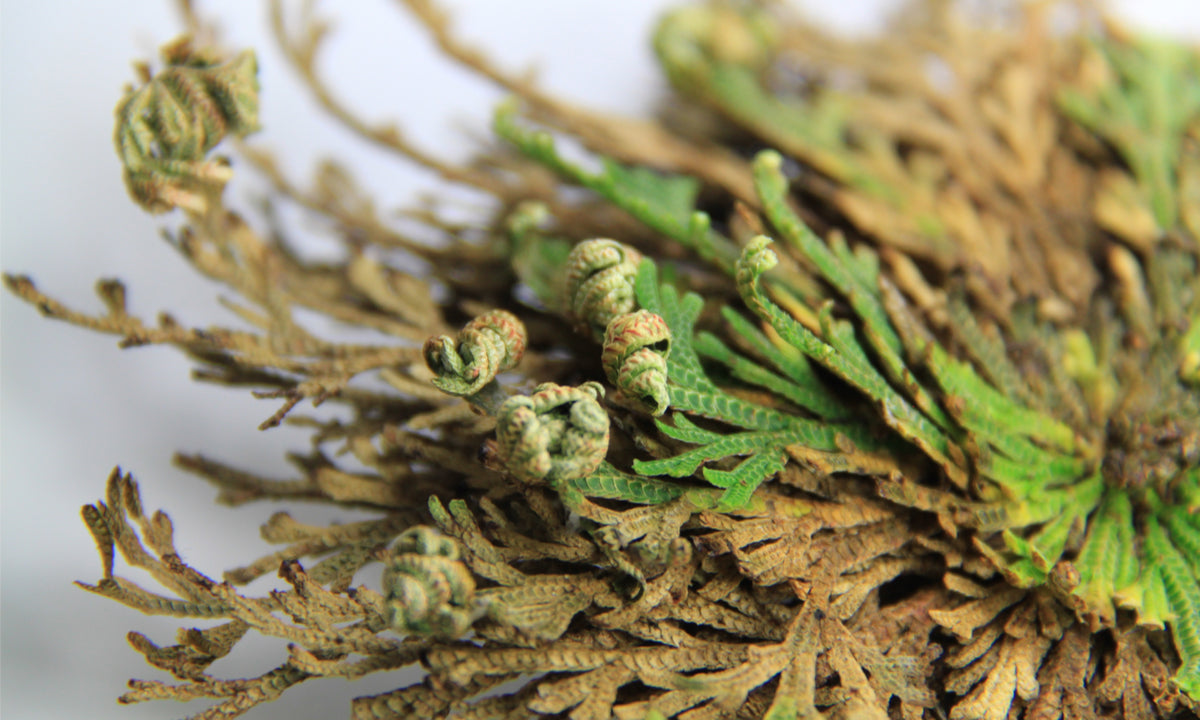Your Cart is Empty
FREE SHIPPING on US orders over $45. Save 25% With Code TAKE25 at checkout.
FREE SHIPPING on US orders over $45. Save 25% With Code TAKE25 at checkout.

A plant with the name “resurrection” is sure to raise some eyebrows, but the truth is that this unique plant seems to come back from the dead in real life. The leaves of the plant shrink and appear to die, but when the rain finally comes, this plant springs back to life with a bloom of thousands of tiny bright green leaves that are perfectly designed to catch future raindrops!
The resurrection plant (Myrothamnus flabellifolia) grows in the dry deserts of southern Africa, and is seemingly dead for half of the year. It’s miraculous resurrection when the rains finally come to the desert is what has given this woody plant its mystique. Some also refer to it as The Rose of Jericho.
It was used in traditional African medicine and is still used today to treat a variety of ailments. The leaves contain essential oils that include camphor and eucalyptol and are often brewed into a medicinal tea. Some use the entire plant to treat colds and respiratory ailments.
Researchers have studied the secondary metabolites of the resurrection plant, which is often used in Africa as a topical ointment to help with wound healing. In addition, other studies have found that the secondary metabolites found in resurrection plants have biological activities that may be important to medicine, including antiviral, antifungal and antibacterial properties. Many other studies are underway.
With the growing interest in the benefits of the resurrection plant, one particular element has come to the forefront: antioxidant properties. Watching the resurrection plant return from what appears to be “the dead” is a miracle in itself, but what the plant’s properties can do for skin is equally as stunning.
Due to its antioxidant properties, the resurrection plant is able to ward off free radical damage. This damage can decimate the skin cells’ DNA and mitochondria, altering skin's ability to produce collagen and elastin. Free radical damage results in a loss of elasticity in the skin and makes the skin appear older than its chronological age.
Free radicals are unstable molecules that only have one electron, and are thought to be responsible for all types of skin cell damage. The only defense against free radicals is antioxidants. The body produces these naturally, but unfortunately the body can’t produce the quantity needed quickly enough to battle free radicals.
Topical applications of antioxidants can help support the body’s defense against those free radicals and help prevent premature skin aging, sagging skin, hyperpigmentation or “age spots” and other maladies that can occur.
he sun’s UV rays are what cause a lot of skin damage, causing what is called “photoaging.” This premature aging can be altered using antioxidants, which is why many cosmetic skincare products contain the extract of the resurrection plant thanks to its abundance of antioxidants.
While the resurrection plant extract is known to contain antioxidants, another key benefit of using the plant in skincare formulations is its moisturizing capabilities.
Think of what this plant does, going from a dry, dormant state to one of green, lush beauty in a matter of minutes when stimulated by rain. The same principal applies to what the extract from the resurrection plant can do for dry skin.
Resurrection plant extract has the ability to hydrate skin in its deepest layers, while nourishing it and helping it to retain moisture. Dry skin is one of the results of free radical damage as well as skin that has not been moisturized properly. The resurrection plant extract can help turn that dry skin into highly moisturized, radiant softness, providing a more youthful appearance when it’s applied.
Properly moisturized skin helps to give it a soft, smooth tactile feel. Moisturizing skin is what gives skin the ability to retain moisture, helping to prevent skin from drying out.
Applying moisture to your face can help to boost the stratum corneum’s moisture level, providing a more youthful appearance. The stratum corneum is the top layer of skin, and consists of fat, oil, and skin cells that help retain moisture. Keeping skin properly moisturized is a key step in keeping skin healthy.
The topical application of the extract from the resurrection plant offers great hope for skin problems. The plant's extract is shown to be super hydrating, protective, and filled with antioxidant properties. But perhaps the best benefit of the plant’s extract is the ability to help regenerate damaged skin cells.
Some researchers believe that this ability to help regenerate skin cells is due to the extract’s antioxidant properties, but others believe it is a combination of the plant’s ability to rehydrate itself coupled with the antioxidant properties that gives the resurrection plant its unique abilities.
To begin a regimen for your skin, look for products that contain resurrection plant extract, as well as those that have super moisturizing abilities along with high levels of antioxidants.
Your daily moisturizer and hydrating face serums are two products in which resurrection plant can pack big benefits. Remember, some labels might list the plant by its botanical name, Myrothamnus flabellifolia.
It is the unique synergy of moisture and antioxidants within the Resurrection Plant that hold great promise for bringing damaged skin back to life.